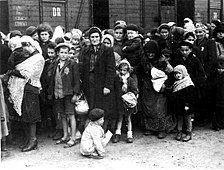
Back Porajmos ALS إبادة الغجر الروم Arabic Porajmos Azerbaijani Porajmos Breton Holokaust nad Romima BS Porraimos Catalan کۆمەڵکوژی دۆمەکان CKB Porajmos Czech Porajmos German Γενοκτονία των Ρομά Greek
| Romani Holocaust | |
|---|---|
| Part of World War II | |
 European Roma and Sinti in Asperg, Nazi Germany, are rounded up for deportation by Nazi German authorities on 22 May 1940. | |
| Location | German-occupied Europe |
| Date | 1939–1945[1][2] |
| Target | European Roma and Sinti |
Attack type | Genocide, ethnic cleansing, mass murder, starvation, mass shooting, concentration camps, death camps |
| Deaths | At least 150,000. Other estimates give figures such as 500,000[3] 800,000[4] or even as high as 1.5 million.[5]: 383–396 |
| Perpetrators | Nazi Germany and its allies |
| Motive | Antiziganism, Germanisation, Pan-Germanism, Racism, Nazi racial policy |
| Part of a series on |
| The Holocaust |
|---|
 |

| This article is part of a series on |
| Eugenics |
|---|
The Romani Holocaust[6] was the genocide of European Roma and Sinti people during World War II.[7] Beginning in 1933, Nazi Germany systematically persecuted the European Roma, Sinti and other peoples pejoratively labeled 'Gypsy' through forcible internment and compulsory sterilization. German authorities summarily and arbitrarily subjected Romani people to incarceration, forced labor, deportation and mass murder in concentration and extermination camps.[8]
Under Adolf Hitler, a supplementary decree to the Nuremberg Laws was issued on 26 November 1935, classifying the Romani people (or Roma) as "enemies of the race-based state", thereby placing them in the same category as the Jews. Thus, the fate of the Roma in Europe paralleled that of the Jews in the Holocaust.[3]
Historians estimate that between 250,000 and 500,000 Romani and Sinti were killed by Nazi Germans and their collaborators—25% to over 50% of the estimate of slightly fewer than 1 million Roma in Europe at the time.[3] Later research cited by Ian Hancock estimated the death toll to be at about 1.5 million out of an estimated 2 million European Roma.[5]
In 1982, West Germany formally recognized that Nazi Germany had committed genocide against the Romani people.[9][10] In 2011, Poland officially adopted 2 August as a day of commemoration of the Romani genocide.[11]
Within the Nazi German state, first persecution, then extermination, was aimed primarily at sedentary "Gypsy mongrels". In December 1942, Heinrich Himmler ordered the deportation of all Roma from the Greater Germanic Reich, and most were sent to the specially established Gypsy concentration camp at Auschwitz-Birkenau. Other Roma were deported there from the Nazi-occupied Western European territories. Approximately 21,000 of the 23,000 European Roma and Sinti sent there did not survive. In areas outside the reach of systematic registration, e.g., in the German-occupied areas of Eastern and Southeastern Europe, the Roma who were most threatened were those who, in the German judgment, were "vagabonds", though some were actually refugees or displaced persons. Here, they were killed mainly in massacres perpetrated by the German military and police formations as well as by the Schutzstaffel (SS) task forces, and in armed resistance against the Nazi German occupation of Europe.[3]
- ^ Benz, Wolfgang (1999). The Holocaust: A German Historian Examines the Genocide (1st ed.). Columbia University Press. pp. 119–131. ISBN 0-231-11215-7.
- ^ "Genocide of European Roma (romani People), 1939–1945". United States Holocaust Memorial Museum. Retrieved 12 April 2024.
- ^ a b c d "Holocaust Encyclopedia – Genocide of European Roma (Gypsies), 1939–1945". USHMM. Archived from the original on 19 June 2024. Retrieved 9 August 2011.
- ^ Brzezinski, Zbigniew (2010). Out of Control: Global Turmoil on the Eve of the 21st Century. Simon & Schuster (Touchstone). p. 10. ISBN 978-1-4391-4380-3.,
- ^ a b Hancock, Ian (2005), "True Romanies and the Holocaust: A Re-evaluation and an overview", The Historiography of the Holocaust, Palgrave Macmillan, pp. 383–396, ISBN 978-1-4039-9927-6, archived from the original on 28 September 2011
- ^ also known as the Porajmos (Romani pronunciation: IPA: [pʰoɽajˈmos], meaning "the Devouring"), the Pharrajimos (meaning "the Cutting up", "the Fragmentation", "the Destruction"), and the Samudaripen ("Mass killing")
- ^ Davis, Mark (5 May 2015). "How World War II shaped modern Germany". euronews.
- ^ "Genocide of European Roma (Gypsies), 1939–1945". encyclopedia.ushmm.org. Retrieved 12 November 2024.
- ^ "Germany unveils Roma Holocaust memorial". Al Jazeera. 24 October 2012. Archived from the original on 11 July 2023. Retrieved 8 March 2015.
- ^ "Holocaust Memorial Day: 'Forgotten Holocaust' of Roma finally acknowledged in Germany". The Daily Telegraph. 27 January 2011. Archived from the original on 2 April 2015. Retrieved 8 March 2015.
- ^ Cite error: The named reference
Polandwas invoked but never defined (see the help page).